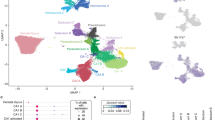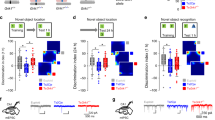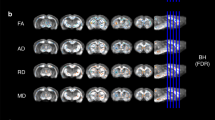Abstract
Hippocampal pathology is likely to contribute to cognitive disability in Down syndrome, yet the neural network basis of this pathology and its contributions to different facets of cognitive impairment remain unclear. Here we report dysfunctional connectivity between dentate gyrus and CA3 networks in the transchromosomic Tc1 mouse model of Down syndrome, demonstrating that ultrastructural abnormalities and impaired short-term plasticity at dentate gyrus–CA3 excitatory synapses culminate in impaired coding of new spatial information in CA3 and CA1 and disrupted behavior in vivo. These results highlight the vulnerability of dentate gyrus–CA3 networks to aberrant human chromosome 21 gene expression and delineate hippocampal circuit abnormalities likely to contribute to distinct cognitive phenotypes in Down syndrome.
This is a preview of subscription content, access via your institution
Access options
Subscribe to this journal
Receive 12 print issues and online access
$209.00 per year
only $17.42 per issue
Buy this article
- Purchase on Springer Link
- Instant access to full article PDF
Prices may be subject to local taxes which are calculated during checkout







Similar content being viewed by others
References
Reeves, R.H. et al. A mouse model for Down syndrome exhibits learning and behaviour deficits. Nat. Genet. 11, 177–184 (1995).
Yu, T. et al. A mouse model of Down syndrome trisomic for all human chromosome 21 syntenic regions. Hum. Mol. Genet. 19, 2780–2791 (2010).
Pereira, P.L. et al. A new mouse model for the trisomy of the Abcg1–U2af1 region reveals the complexity of the combinatorial genetic code of down syndrome. Hum. Mol. Genet. 18, 4756–4769 (2009).
Kesslak, J.P., Nagata, S.F., Lott, I. & Nalcioglu, O. Magnetic resonance imaging analysis of age-related changes in the brains of individuals with Down's syndrome. Neurology 44, 1039–1045 (1994).
Raz, N. et al. Selective neuroanatomic abnormalities in Down's syndrome and their cognitive correlates: evidence from MRI morphometry. Neurology 45, 356–366 (1995).
Aylward, E.H. et al. MRI volumes of the hippocampus and amygdala in adults with Down's syndrome with and without dementia. Am. J. Psychiatry 156, 564–568 (1999).
Pinter, J.D., Eliez, S., Schmitt, J.E., Capone, G.T. & Reiss, A.L. Neuroanatomy of Down's syndrome: a high-resolution MRI study. Am. J. Psychiatry 158, 1659–1665 (2001).
Pennington, B.F., Moon, J., Edgin, J., Stedron, J. & Nadel, L. The neuropsychology of Down syndrome: evidence for hippocampal dysfunction. Child Dev. 74, 75–93 (2003).
Edgin, J.O. et al. Development and validation of the Arizona Cognitive Test Battery for Down syndrome. J. Neurodev. Disord. 2, 149–164 (2010).
Duchon, A. et al. Identification of the translocation breakpoints in the Ts65Dn and Ts1Cje mouse lines: relevance for modeling Down syndrome. Mamm. Genome 22, 674–684 (2011).
Reinholdt, L.G. et al. Molecular characterization of the translocation breakpoints in the Down syndrome mouse model Ts65Dn. Mamm. Genome 22, 685–691 (2011).
Kurt, M.A., Kafa, M.I., Dierssen, M. & Davies, D.C. Deficits of neuronal density in CA1 and synaptic density in the dentate gyrus, CA3 and CA1, in a mouse model of Down syndrome. Brain Res. 1022, 101–109 (2004).
Kleschevnikov, A.M. et al. Hippocampal long-term potentiation suppressed by increased inhibition in the Ts65Dn mouse, a genetic model of Down syndrome. J. Neurosci. 24, 8153–8160 (2004).
Belichenko, P.V. et al. Excitatory-inhibitory relationship in the fascia dentata in the Ts65Dn mouse model of Down syndrome. J. Comp. Neurol. 512, 453–466 (2009).
Belichenko, P.V. et al. Synaptic structural abnormalities in the Ts65Dn mouse model of Down Syndrome. J. Comp. Neurol. 480, 281–298 (2004).
Popov, V.I., Kleschevnikov, A.M., Klimenko, O.A., Stewart, M.G. & Belichenko, P.V. Three-dimensional synaptic ultrastructure in the dentate gyrus and hippocampal area CA3 in the Ts65Dn mouse model of Down syndrome. J. Comp. Neurol. 519, 1338–1354 (2011).
O'Doherty, A. et al. An aneuploid mouse strain carrying human chromosome 21 with Down syndrome phenotypes. Science 309, 2033–2037 (2005).
Morice, E. et al. Preservation of long-term memory and synaptic plasticity despite short-term impairments in the Tc1 mouse model of Down syndrome. Learn. Mem. 15, 492–500 (2008).
Rolls, E.T. A computational theory of episodic memory formation in the hippocampus. Behav. Brain Res. 215, 180–196 (2010).
Henze, D.A., Wittner, L. & Buzsaki, G. Single granule cells reliably discharge targets in the hippocampal CA3 network in vivo. Nat. Neurosci. 5, 790–795 (2002).
Hanson, J.E. & Madison, D.V. Imbalanced pattern completion vs. separation in cognitive disease: network simulations of synaptic pathologies predict a personalized therapeutics strategy. BMC Neurosci. 11, 96 (2010).
Nicoll, R.A. & Schmitz, D. Synaptic plasticity at hippocampal mossy fiber synapses. Nat. Rev. Neurosci. 6, 863–876 (2005).
Bourne, J.N. & Harris, K.M. Coordination of size and number of excitatory and inhibitory synapses results in a balanced structural plasticity along mature hippocampal CA1 dendrites during LTP. Hippocampus 21, 354–373 (2011).
Acsády, L., Kamondi, A., Sik, A., Freund, T. & Buzsaki, G. GABAergic cells are the major postsynaptic targets of mossy fibers in the rat hippocampus. J. Neurosci. 18, 3386–3403 (1998).
Scott, R., Lalic, T., Kullmann, D.M., Capogna, M. & Rusakov, D.A. Target-cell specificity of kainate autoreceptor and Ca2+-store-dependent short-term plasticity at hippocampal mossy fiber synapses. J. Neurosci. 28, 13139–13149 (2008).
Cheng, J. & Ji, D. Rigid firing sequences undermine spatial memory codes in a neurodegenerative mouse model. Elife 2, e00647 (2013).
Cabral, H.O. et al. Oscillatory dynamics and place field maps reflect hippocampal ensemble processing of sequence and place memory under NMDA receptor control. Neuron 81, 402–415 (2014).
Niewoehner, B. et al. Impaired spatial working memory but spared spatial reference memory following functional loss of NMDA receptors in the dentate gyrus. Eur. J. Neurosci. 25, 837–846 (2007).
Belichenko, N.P. et al. The “Down syndrome critical region” is sufficient in the mouse model to confer behavioral, neurophysiological, and synaptic phenotypes characteristic of Down syndrome. J. Neurosci. 29, 5938–5948 (2009).
Park, J., Song, W.J. & Chung, K.C. Function and regulation of Dyrk1A: towards understanding Down syndrome. Cell. Mol. Life Sci. 66, 3235–3240 (2009).
Ferrer, I. & Gullotta, F. Down's syndrome and Alzheimer's disease: dendritic spine counts in the hippocampus. Acta Neuropathol. 79, 680–685 (1990).
McHugh, T.J. et al. Dentate gyrus NMDA receptors mediate rapid pattern separation in the hippocampal network. Science 317, 94–99 (2007).
Lanfranchi, S., Carretti, B., Spano, G. & Cornoldi, C. A specific deficit in visuospatial simultaneous working memory in Down syndrome. J. Intellect. Disabil. Res. 53, 474–483 (2009).
Guidi, S. et al. Neurogenesis impairment and increased cell death reduce total neuron number in the hippocampal region of fetuses with Down syndrome. Brain Pathol. 18, 180–197 (2008).
Smith, G.K., Kesner, R.P. & Korenberg, J.R. Dentate gyrus mediates cognitive function in the Ts65Dn/DnJ mouse model of down syndrome. Hippocampus 24, 354–362 (2014).
Jones, M.W. & McHugh, T.J. Updating hippocampal representations: CA2 joins the circuit. Trends Neurosci. 34, 526–535 (2011).
Hanson, J.E., Blank, M., Valenzuela, R.A., Garner, C.C. & Madison, D.V. The functional nature of synaptic circuitry is altered in area CA3 of the hippocampus in a mouse model of Down's syndrome. J. Physiol. (Lond.) 579, 53–67 (2007).
Witton, J., Brown, J.T., Jones, M.W. & Randall, A.D. Altered synaptic plasticity in the mossy fiber pathway of transgenic mice expressing mutant amyloid precursor protein. Mol. Brain 3, 32 (2010).
Gardiner, K.J. Molecular basis of pharmacotherapies for cognition in Down syndrome. Trends Pharmacol. Sci. 31, 66–73 (2010).
Fernandez, F. et al. Pharmacotherapy for cognitive impairment in a mouse model of Down syndrome. Nat. Neurosci. 10, 411–413 (2007).
Kishnani, P.S. et al. Donepezil for treatment of cognitive dysfunction in children with Down syndrome aged 10–17. Am. J. Med. Genet. 152A, 3028–3035 (2010).
Conners, F.A., Rosenquist, C.J., Arnett, L., Moore, M.S. & Hume, L.E. Improving memory span in children with Down syndrome. J. Intellect. Disabil. Res. 52, 244–255 (2008).
Contestabile, A., Benfenati, F. & Gasparini, L. Communication breaks-Down: from neurodevelopment defects to cognitive disabilities in Down syndrome. Prog. Neurobiol. 91, 1–22 (2010).
Fiala, J.C. & Harris, K.M. Cylindrical diameters method for calibrating section thickness in serial electron microscopy. J. Microsc. 202, 468–472 (2001).
Nevian, T. & Helmchen, F. Calcium indicator loading of neurons using single-cell electroporation. Pflugers Arch. 454, 675–688 (2007).
Scott, R. & Rusakov, D.A. Main determinants of presynaptic Ca2+ dynamics at individual mossy fiber-CA3 pyramidal cell synapses. J. Neurosci. 26, 7071–7081 (2006).
Schmitzer-Torbert, N., Jackson, J., Henze, D., Harris, K. & Redish, A.D. Quantitative measures of cluster quality for use in extracellular recordings. Neuroscience 131, 1–11 (2005).
Acknowledgements
Thanks to A. Slender, H. Davies and D. Ford for expert technical assistance and to the Wellcome Trust (Programme Grant to E.M.C.F., V.L.J.T. and M.W.J., Principal Fellowship to D.A.R.), the UK Medical Research Council (grant to E.M.C.F. and V.L.J.T., Industrial Collaborative Studentship to J.W.), Biotechnology and Biological Sciences Research Council (grant to M.G.S.), European Research Council Advanced Grant and FP7 ITN Extrabrain (to D.A.R.) Russian Science Foundation grant 15-14-30000 (to D.A.R.) and Russian Foundation for Basic Research grant 08-04-00049a (to V.I.P.) for financial support.
Author information
Authors and Affiliations
Contributions
E.M.C.F. and V.L.J.T. designed the Tc1 mouse model and initiated the study. J.W., D.M.C. and A.T. performed extracellular in vitro electrophysiology and analyses; V.I.P. and I.K. performed electron microscopy and volumetric experiments and analyses; R.P. and T.P.J. performed two-photon imaging and intracellular electrophysiological recording and analyses; J.W. and L.E.Z. performed in vivo electrophysiology and analyses; S.J.L. performed behavioral experiments and analyses; and J.T.B., A.D.R., D.M.B., F.A.E., M.G.S., D.A.R. and M.W.J. designed experiments, performed data analyses and wrote the paper.
Corresponding author
Ethics declarations
Competing interests
The authors declare no competing financial interests.
Integrated supplementary information
Supplementary Figure 1 Normal granule cell excitability in Tc1 mice.
Pooled stimulus-response curves showing the mean ± SEM amplitude of antidromically-evoked compound action potential recorded in the granule cell (GC) layer of dentate gyrus (DG) vs. the strength of stimulation applied to mossy fibers in area CA3. Data are pooled from slices prepared from 7 wild-type (WT) and 6 Tc1 mice. Inset traces show example responses at 50, 150 and 300µA stimulation. Scale bar: 1ms, 5mV. P=0.70, F(1,11)=0.15, two-way mixed ANOVA.
Supplementary Figure 2 Normal synaptic function in the Schaffer collateral pathway in Tc1 mice.
(a) Pooled CA3-CA1 stimulus-response curves for recordings made in hippocampal slices from wild-type (WT) and Tc1 mice (mean ± SEM). Inset traces show overlaid example responses to 20, 40 and 80V stimulation for the two genotypes. (b) Pooled CA3-CA1 paired-pulse facilitation curves for paired stimuli delivered over inter-stimulus intervals from 25-400ms. Traces show example responses at each inter-stimulus interval. (c) Pooled data from CA3-CA1 LTP experiments in wild-type and Tc1 mice. Arrow denotes delivery of the conditioning stimulus (200ms, 100Hz repeated 3x at 1.5s intervals). Traces show example responses at times a and b. Scale bars: 5ms, 0.25mV.
Supplementary Figure 3 Normal hippocampal volumes and dentate granule cell and CA3 pyramidal cell densities in Tc1 mice.
(a) Hippocampus:brain volume ratios in wild-type (WT) and Tc1 mice. For each box-plot, the center line illustrates the median and box limits indicate the 25th and 75th percentiles (determined using R software). Whiskers extend to the minimum and maximum values. Individual data points are plotted as open circles. n=4, 5, 4, 4 mice per sample respectively. (b) Dentate gyrus (DG) granule cell densities (per mm3) in wild-type (n=3) and Tc1 (n=3) mice. (c) Area CA3 pyramidal cell densities (per mm3) in wild-type (n=3) and Tc1 (n=3) mice.
Supplementary Figure 4 Three-dimensional reconstructions of CA3 dendritic segments, thorny excrescences and postsynaptic densities in wild-type and Tc1 mice.
Dendritic segments and associated presynaptic giant boutons from (a) wild-type and (f) Tc1 mice. Boutons are shown separately in (b) for the wild-type example. Typical examples of thorny excrescences with their postsynaptic densities (PSD) shown in red from (c-d) wild-type and (g) Tc1 mice. 10 representative PSDs from (e) wild-type and (h) Tc1 mice, showing reduced PSD volume in Tc1 animals.
Supplementary Figure 5 Schematic comparison of thorny excrescences in wild-type and Tc1 mice.
(a) Wild-type mice. (b) Tc1 mice. Prominent features in the Tc1 mice are: (1) retraction of thorns on thorny excrescences (yellow); (2) decrease in the volume of mossy fibre giant boutons (blue); (3) rearrangements of postsynaptic densities (PSD; red); (4) retraction of mitochondria from thorny excrescences (green). Note that dendritic spines in CA1 and dentate gyrus do not contain mitochondria.
Supplementary information
Supplementary Text and Figures
Supplementary Figures 1–5 (PDF 825 kb)
Rights and permissions
About this article
Cite this article
Witton, J., Padmashri, R., Zinyuk, L. et al. Hippocampal circuit dysfunction in the Tc1 mouse model of Down syndrome. Nat Neurosci 18, 1291–1298 (2015). https://doi.org/10.1038/nn.4072
Received:
Accepted:
Published:
Issue Date:
DOI: https://doi.org/10.1038/nn.4072
This article is cited by
-
Experience-dependent changes in hippocampal spatial activity and hippocampal circuit function are disrupted in a rat model of Fragile X Syndrome
Molecular Autism (2022)
-
Mouse models of aneuploidy to understand chromosome disorders
Mammalian Genome (2022)
-
REV-ERB in GABAergic neurons controls diurnal hepatic insulin sensitivity
Nature (2021)
-
Gene expression dysregulation domains are not a specific feature of Down syndrome
Nature Communications (2019)
-
Nanoscale diffusion in the synaptic cleft and beyond measured with time-resolved fluorescence anisotropy imaging
Scientific Reports (2017)



